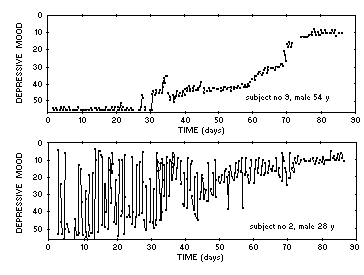
| FIG. 2 |
 |
| Longitudinal registration of self-ratings of depressed mood using the Adjective Mood Scale (this method is described in ref. 2) three times daily, at 9 a.m., 5 p.m., and 10 p.m. in major depressive patients throughout their entire hospitalization period. Two extreme examples of data-sets are (top) a patient without any large fluctuations of mood but a slow and steady improvement, and (bottom), a similar long-term improvement at the end of a long period of large diurnal mood swings. In this patient, most of the days were characterized by severe depression in the morning and euthymia in the evening. Reprinted with permission from Gordijn et al. (in preparation). |
| Back to Chapter |
published 2000